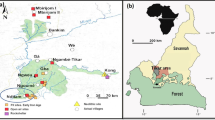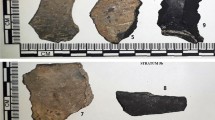Abstract
The role of microfossils for the ceramic paste characterization has been revealed through firing experiment. Ceramic samples were prepared with the clay of Monte San Giorgio (Sicily, Italy), that contains many microfossils that suffered relevant changes in the microstructure and chemical composition during firing temperature. The samples were fired at different conditions according to the presumed ancient techniques. The alteration and/or decomposition of mineral phases with temperature was observed with optical and electron microscopy by monitoring the mineral modifications at different firing conditions. In order to validate our approach on archaeological material, the analyses were performed also on ceramic fragments, furnished by the Ceramics Regional Museum “Antonino Ragona” of Caltagirone. The micropaleontological study, as component of the archaeometric analyses, seems to be a useful archaeothermometry for the evaluation of firing processes and sometimes decisive to distinguish the characteristics of the clay used in a given production.














Similar content being viewed by others
References
Alaimo R, Giarrusso R, Iliopoulos I, Montana G (2002) Archaic and classical ceramic artefacts from Caltagirone (Sicily): a first attempt for distinguishing imports and local imitations through petrography and chemistry. Periodico di Mineralogia 71:17–31
Ardizzone F (1999) Le anfore recuperate sopra le volte del palazzo della Zisa e la produzione di ceramica comune a Palermo tra la fine dell’XI ed il XII secolo. Mélanges de l’Ecole française de Rome. Moyen-Age, Temps modernes, pp 7–50
Barone G, Lo Giudice A, Mazzoleni P, Pezzino A, Barilaro D, Crupi V, Triscari M (2005) Chemical characterization and statistical multivariate analysis of ancient pottery from Messina, Catania, Lentini and Siracusa (Sicily). Archaeometry 47:745–762
Belfiore CM, Day PM, Hein A, Kilikoglou V, La Rosa V, Mazzoleni P, Pezzino A (2007) Petrographic and chemical characterization of pottery production of the Late Minoan I kiln at Hagia Triada, Crete. Archaeometry 49:621–653
Bonanno C (1998) I sarcofagi fittili della Sicilia. L’ERMA di Bretschneider, Roma
Brissaud I, Houdayer A (1986) Sponge spicules as a characteristic of ancient African pottery from Mali. J Field Archaeol 13:357–359
Burrafato G, Gueli AM, Nicastro E, Privitera A, Stella G, Troja SO, Zuccarello AR (2009) Terracotta calatina: dalla produzione alla caratterizzazione archeometrica. Atti del Congresso Nazionale Società Italiana di Fisica, Bari, 28 settembre-3 ottobre 2009, p 110
Cita MB (1975) Studi sul Pliocene e gli strati di passaggio dal Miocene al Pliocene, VII. Planktonic foraminiferal biozonation of the Mediterranean Pliocene deep-sea record:a revision. Riv Ital Paleontol S 81:527–544
Cuomo Di Caprio N (2007) Ceramica in archeologia 2—antiche tecniche di lavorazione e moderni metodi di indagine. L’ERMA di Bretschnider, Roma, pp 91, 92, 494, 495
Di Grande A, Giandinoto V (2002) Plio-Pleistocene sedimentary facies and their evolution in centre-south-eastern Sicily: a working hypothesis. EGU Stephan Mueller Spec Publ Ser 1:211–221
Flugel E (2004) Microfacies of carbonate rocks, analysis, interpretation and application. Springer, Berlin, Heidelberg, New York
Gliozzo E, Memmi Turbanti I (2004) Black gloss pottery: production sites and technology in northern Etruria. Part I: provenance studies. Archaeometry 46:201–227
Gosselain OP (1992) Bonfire of the enquiries. Pottery firing temperatures in archaeology: what for? J Archaeol Sci 19:243–259
Gradstein FM, Ogg J, Smith A (2004) A geologic time scale 2004. Cambridge University Press, Cambridge, UK
Grasso M, Butler RWH, La Manna F (1991) Thin skinned deformation and structural evolution in the NE segment of the Gela Nappe, SE Sicily. Studi Geologici Camerti, Edimond, Camerino, Volume Speciale, pp 9–17
Gueli AM, Privitera A, Nicastro E, Stella G, Troja SO (2011) Ceramic of Caltagirone, from production to archaeometric characterization. In: Macchia A, Greco E, Chiarandà BA, Barbabietola N (eds) Contribute and role of youth in conservation of cultural heritage. YOCOCU, Palermo, pp 107–118
Hein A, Day PM, Quinn PS, Kilikoglou V (2004) The geochemical diversity of Neogene clay deposits and its implications for provenance studies of Minoan pottery. Archaeometry 46:357–384
Iaccarino S (1985) Mediterranean Miocene and Pliocene planktic foraminifera. In: Bolli HM, Saunders JB, Perch-Nielsen K (eds) Plankton stratigraphy, Cambridge University Press, Cambridge, UK, pp 283–314
Jansma MJ (1990) Diatoms from a Neolithic excavation on the former island of Schokland, Ijselmeepolders, the Netherlands. Diatom Res 5:301–309
Maggetti M, Olin JS, Franklin AD (1982) Phase analysis and its significance for technology and origin. In: Olin JS, Franklin AD (eds) Archaeological Ceramics. Smithsonian Institution, Washington, pp 121–133
Maritan L, Mazzoli C, Freestone I (2007) Modelling changes in mollusc shell internal microstructure during firing: implications for temperature estimation in shell-bearing pottery. Archaeometry 49:529–541
Mirti P, Gulmini M, Pace M, Elia D (2004) The provenance of red figure vases from Locri Epizephiri (Southern Italy): new evidence by chemical analysis. Archaeometry 46:183–200
Montana G, Caruso A, Lavore AT, Polito AM, Sulli A (2006) Definizione delle “argille ceramiche” presenti nella Sicilia nord-occidentale: inquadramento geologico e ricaduta di carattere archeometrico, Il Quaternario. Ital J Q Sci 19:277–296
Montana G, Polito AM, Sulli A, Caruso A, Azzaro E (2011) Le “argille ceramiche” della Sicilia occidentale e centrale. IlionBooks, Enna
Quinn PS (1999) A note on the behavior of calcareous nannofossils during the firing of ceramics. J Nannoplankton Res 21:31–32
Quinn PS (2008) The occurrence and research potential of microfossils in inorganic archaeological materials. Geoarchaeology 23:275–291
Quinn PS, Day PM (2007) Calcareous microfossils in bronze age aegean ceramics: illuminating technology and provenance. Archaeometry 49:775–793
Quinn PS, Alaimo R, Montana G (1998) Calcareous nannofossil analysis of ceramics and probable raw materials from an ancient Punic kiln site on the island of Mozia, western Sicily. J Nannoplankton Res 20:85–87
Rao A, Guido A, Mastandrea A, Perri E, Romano C, Russo F, Di Stefano E (2006) Integrated calcareous plankton biostratigraphy of selected Miocene successions in the Northern Calabria (Italy). Boll Soc Paleont It 45:115–132
Rio D, Raffi I, Villa G (1990) Pliocene–Pleistocene calcareous nannofossil distribution patterns in the Western Mediterranean. In: Kastens KA, Mascle J (eds) Proceedings of the Ocean Drilling Program, Scientific Results, College Station, Texas, vol 107, pp 513–533
Rio D, Sprovieri R, Di Stefano E (1994) The Gelasian Stage: a proposal of a new cronostratigraphy unit of the Pliocene series. Riv Ital Paleontol S 100(1):103–124
Sprovieri R (1992) Mediterranean Pliocene biochronology: a high resolution record based on quantitative planktonic foraminifer distribution. Riv Ital Paleontol S 98:61–100
Sprovieri R (1993) Pliocene-early Pleistocene astronomically forced planktonic foraminifer abundance fluctuations and chronology of Mediterranean calcareous plankton bio-events. Riv Ital Paleontol S 99:371–414
Tite MS, Maniatis Y (1975) Scanning electron microscopy of fired calcareous clays. T Br Ceram Soc 74:19–22
Violanti D (2012) Pliocene Mediterranean foraminiferl biostratigraphy: a synthesis and application to the paleoenvironmental evolution of Northwestern Italy. In: Ömer E (ed) Stratigraphic analysis of layered deposits, ISBN: 978-953-51-0578-7, InTech, Rijeka. http://www.intechopen.com/books/stratigraphicanalysis-of-layered-deposits/pliocene-mediterranean-foraminiferl-biostratigraphy-a-synthesis-and-applicationto-the-paleoenviro. Accessed 8 April 2015
Walker JD, Geissman JW (2009) Geologic time scale. Geological Society of America. doi:10.1130/2009.CTS004R2C
Webb TL, Kruger JE (1970) Carbonates. In: Mackenzie RC (ed) Differential thermal analysis. Academic Press, London, pp 303–342
Wilkinson IP, Tasker A, Gouldwell A, Williams M, Edgeworth M, Zalasiewicz J, Christie N (2010) Micropalaeontology reveals the source of building materials for a defensive earthwork (English Civil War?) at Wallingford Castle, Oxfordshire. J Micropaleontol 29:89–92
Yoon YY, Lee KY, Chung KS, Yang MK, Kim KH (2001) Classification of Korean old potteies by trace elements analysis. J Radioanal Nucl Chem 248:89–92
Acknowledgments
We wish to tank Giovanni Patti and Silvano Marino who furnished the archaeological samples. The experimental samples were provided by the laboratory PH3DRA (Physics for Dating, Diagnostic, Dosimetry, Research and Applications) of University of Catania.
Author information
Authors and Affiliations
Corresponding author
Rights and permissions
About this article
Cite this article
Privitera, A., Guido, A., Mastandrea, A. et al. Morphological and mineralogical evolution of microfossils during the heating process: a contribution to the archaeometric study of ceramics. Rend. Fis. Acc. Lincei 26, 499–512 (2015). https://doi.org/10.1007/s12210-015-0443-0
Received:
Accepted:
Published:
Issue Date:
DOI: https://doi.org/10.1007/s12210-015-0443-0




